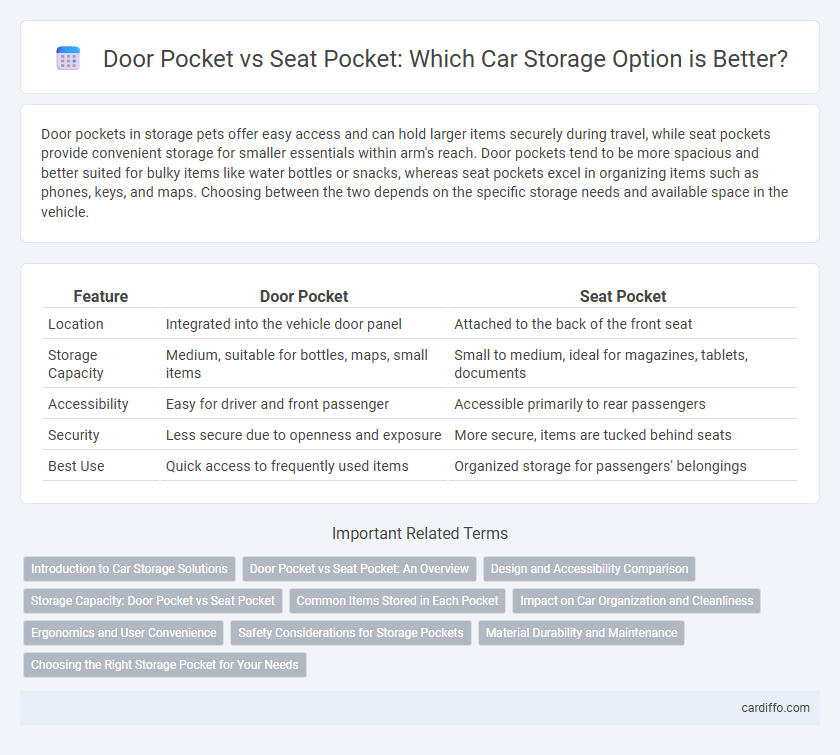Door pockets in storage pets offer easy access and can hold larger items securely during travel, while seat pockets provide convenient storage for smaller essentials within arm's reach. Door pockets tend to be more spacious and better suited for bulky items like water bottles or snacks, whereas seat pockets excel in organizing items such as phones, keys, and maps. Choosing between the two depends on the specific storage needs and available space in the vehicle.
Table of Comparison
| Feature | Door Pocket | Seat Pocket |
|---|---|---|
| Location | Integrated into the vehicle door panel | Attached to the back of the front seat |
| Storage Capacity | Medium, suitable for bottles, maps, small items | Small to medium, ideal for magazines, tablets, documents |
| Accessibility | Easy for driver and front passenger | Accessible primarily to rear passengers |
| Security | Less secure due to openness and exposure | More secure, items are tucked behind seats |
| Best Use | Quick access to frequently used items | Organized storage for passengers' belongings |
Introduction to Car Storage Solutions
Car storage solutions enhance vehicle organization and accessibility by utilizing available spaces like door pockets and seat pockets. Door pockets offer convenient side storage for smaller items such as water bottles and maps, maximizing door panel space without cluttering the cabin. Seat pockets provide rear-seat passengers with easy access to books, tablets, or snacks, improving overall passenger comfort and vehicle tidiness.
Door Pocket vs Seat Pocket: An Overview
Door pockets provide convenient side storage within easy reach, typically offering larger capacity for items like water bottles and maps compared to seat pockets. Seat pockets, usually located on the back of front seats, offer compact storage ideal for documents, magazines, or small personal items without occupying cabin space. Choosing between door pockets and seat pockets depends on the desired accessibility and storage volume for in-car organization.
Design and Accessibility Comparison
Door pockets offer easier accessibility for frequently used items due to their position at arm's reach, while seat pockets are better suited for storing smaller or flat items like manuals and maps. Door pockets often have deeper storage space, improving capacity, but seat pockets maintain a slim profile and avoid cluttering the door area. Design-wise, door pockets integrate seamlessly with the car interior but may restrict door panel aesthetics, whereas seat pockets preserve sleek door designs yet can be harder to access during driving.
Storage Capacity: Door Pocket vs Seat Pocket
Door pockets typically offer greater storage capacity than seat pockets, accommodating larger items such as water bottles, maps, and snacks. Seat pockets usually provide limited space, ideal for slim objects like mobile phones, magazines, or tablets. Maximizing vehicle organization depends on using door pockets for bulkier items and seat pockets for smaller, frequently accessed belongings.
Common Items Stored in Each Pocket
Door pockets commonly store water bottles, umbrellas, and vehicle manuals due to their easy accessibility and larger size. Seat pockets typically hold magazines, tablets, and small electronics, catering to passenger convenience during travel. The choice between door and seat pockets depends on the user's need for accessibility versus organized storage.
Impact on Car Organization and Cleanliness
Door pockets enhance car organization by providing easy access to frequently used items, reducing clutter on seats and floors. Seat pockets help keep the rear area tidy by storing documents, tablets, or small accessories, preventing loose objects from creating mess. Combining both storage options maximizes space utilization, significantly improving overall car cleanliness and order.
Ergonomics and User Convenience
Door pockets offer easy access and improved ergonomics by keeping frequently used items within arm's reach, reducing driver distraction. Seat pockets provide additional storage for larger or less frequently accessed items but can be harder to reach while driving. Prioritizing door pockets enhances user convenience by combining accessibility with ergonomic design, promoting safer and more efficient storage solutions.
Safety Considerations for Storage Pockets
Door pockets offer enhanced safety by keeping items securely within arm's reach without obstructing legroom or emergency exits, reducing the risk of injury during sudden stops. Seat pockets, often positioned behind the seat, risk becoming fire hazards if made of flammable materials and can cause objects to fall out during abrupt movements, potentially causing distractions or injuries. Choosing pockets with breathable, flame-retardant fabrics and secure closures improves overall vehicle safety by minimizing loose objects in the cabin.
Material Durability and Maintenance
Door pockets typically feature hard plastic or molded materials designed for durability and ease of cleaning, making them resistant to scratches, spills, and daily wear. Seat pockets often use fabric or mesh materials, which may offer flexible storage but require more frequent maintenance to prevent stains and wear over time. Choosing door pockets enhances longevity and simplifies upkeep, whereas seat pockets prioritize accessibility but may demand regular cleaning to maintain appearance.
Choosing the Right Storage Pocket for Your Needs
When selecting between a door pocket and a seat pocket for storage, consider accessibility and usage frequency; door pockets offer easy reach for frequently used items while seat pockets provide discreet storage for smaller belongings. Door pockets are typically larger and ideal for holding water bottles, maps, or electronic devices, whereas seat pockets suit slim items like tablets, books, or snacks. Prioritize storage needs based on item size, convenience, and passenger comfort to optimize vehicle organization.
door pocket vs seat pocket Infographic

 cardiffo.com
cardiffo.com